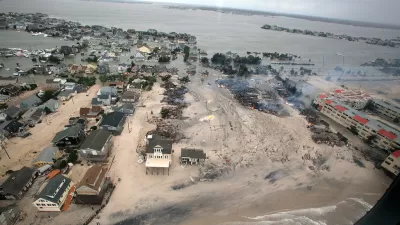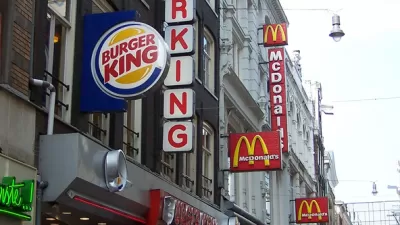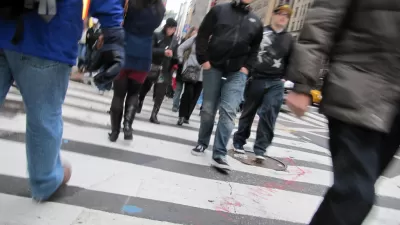Exclusives

FEATURE
The Era of “When, Not If,” Compels a New Approach to Waterfront Development
On the anniversary of Hurricane Sandy, ULI offers guidance on post-disaster rebuilding and building in anticipation of future disasters in a way that helps preserve the environment, boost economic prosperity, and foster a high quality of life.

FEATURE
Why Do Certain Retail Stores Cluster Together?
Ever notice how competitors like Target and Walmart tend to cluster together? Ken Steif has, and through a close analysis of retail location trends in NY, NJ, and CT, he examines which businesses tend to agglomerate and why.
BLOG POST
How the U.S. Became a Unique "Nation of Homezoners”
Exceptionalism is a word often associated with the U.S., most often with foreign policy. Sonia Hirt of VPI argues that since its inception American zoning has also taken a unique form compared to European counterparts.

FEATURE
“Make Love, Not Worse”: On the State of Landscape Preservation
Charles Birnbaum, founder of TCLF, discusses the challenges with preserving and managing significant Modernist landscapes, lifting the veil on the field’s key contributors, and why its easier to love a landscape than a building.
BLOG POST
(Somewhat) Complete Streets
"Complete Streets" policies are a good start, but only a start.
BLOG POST
Eco Districts - The Next Frontier
Moving beyond the building is critical to effecting transformative change toward urban sustainability. Several Swedish projects offer points of inspiration. The Eco District Summit is bringing together people engaged in district-scale sustainability.
BLOG POST
Design Matters
Creating parks that benefit and reflect the needs of the communities that use them is the goal for both planners and landscape architects. Programming is a big part of this. So is design.
BLOG POST
Another Story of a City: Biodiversity
The short-sightedness of overarching proclamations for the right city form obscures the very context in which cities are built and expanded. City planning must become reconnected to its environmental context.

FEATURE
Technology Gives Form and Face to a Forgotten Place
In an excerpt from his new book, Anthony Townsend explains how a volunteer effort is combining consumer technologies with open source GIS to chart one of Africa’s largest and most notorious slums.
BLOG POST
How a Railway Near the Bastille Revolutionized How We Think About Obsolete Infrastructure
Joseph Heathcott presents a historical narrative of the decline, revitalization, and gentrification of the Parisian neighborhood surrounding the Promenade Plantée and Viaduct des Arts, the pioneering repurposing of obsolete urban infrastructure.

FEATURE
The UK’s Most Infamous ‘New Town’ Pioneers a Food System Revolution
Urban agriculture is a promising solution to a variety of ills afflicting our increasingly urbanizing planet. Milton Keynes, Britain's largest New Town of the 20th Century, is forging a path towards food sovereignty by growing its urban farms.
BLOG POST
Gentrification, Shmentrification
Despite media commentary about urban gentrification and the decline of suburbia, suburbs still have far less than a proportionate share of regional poverty.
BLOG POST
LEED-ND Projects Reduce Driving, But Is There a Simpler Way to Measure Success?
New research by Ewing et al finds that vehicle miles traveled in LEED-ND projects may be as much as 60% lower than regional averages. However, objective models of transportation outcomes may prove more efficient than LEED’s points-based system.
BLOG POST
Abu Dhabi Planning Charrette
Abu Dhabi is updating its strategic development plan. Consultant Todd Litman reports on the city's recent urban planning charrette.
BLOG POST
Can Urban Forests Save the Planet?
Urban forests may possess the power to battle climate change. We just have to figure out what is more important: quantity or quality?

FEATURE
A New Breed of Pedestrian Advocate is Making City Streets Safer for Everyone
As cities such as New York recognize the need to stop treating pedestrians as second-class citizens, the Pedestrian/Traffic Manager (PTM) has emerged as a new tool in the effort to improve the mobility and safety of those on foot.
BLOG POST
I have a Problem With Your “Issues”
Good planning requires clear problem and goal statements. Calling a problem an “issue” is ambiguous, which is a real problem.
BLOG POST
Is Turnabout Fair Play?
If American politicans and bureaucrats had favored public transit or pedestrians as aggressively as they favored cars in the 20th century, public policy would be very different indeed.
BLOG POST
A Vision for LA's New Web-Based Zoning Code
For the first time since 1946, Los Angeles is completely revising its zoning code. Urban Insight, the team behind Planetizen, is pleased to be part of this project. One of our key goals is to create a modern web-based version of the zoning code.
BLOG POST
Congestion Costing Point-Counter-Point
Conventional transportation planning tends to exaggerate congestion costs and roadway expansion benefits, and undervalues other transportation solutions such as improving alternative modes, pricing reforms and smart growth policies.
Pagination
Clanton & Associates, Inc.
Jessamine County Fiscal Court
Institute for Housing and Urban Development Studies (IHS)
City of Grandview
Harvard GSD Executive Education
Toledo-Lucas County Plan Commissions
Salt Lake City
NYU Wagner Graduate School of Public Service
Urban Design for Planners 1: Software Tools
This six-course series explores essential urban design concepts using open source software and equips planners with the tools they need to participate fully in the urban design process.
Planning for Universal Design
Learn the tools for implementing Universal Design in planning regulations.


































